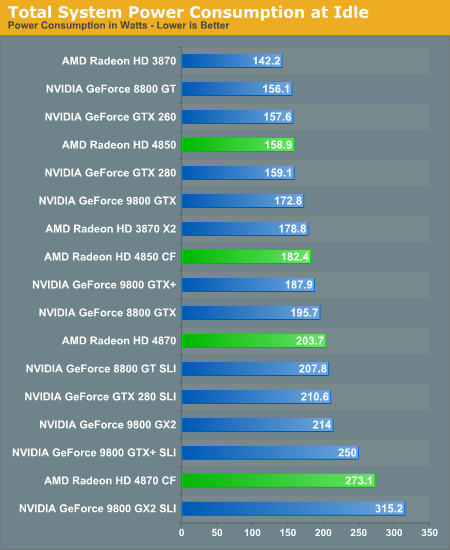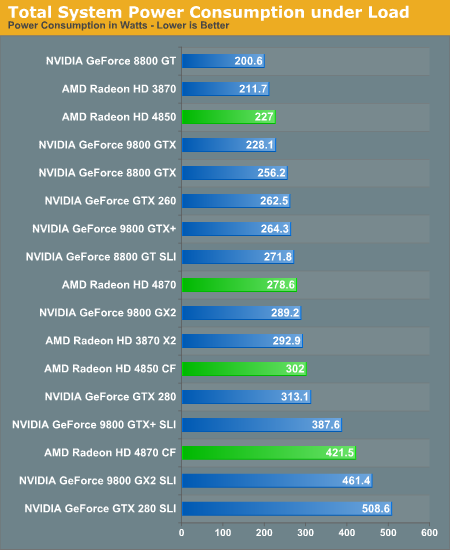The Radeon HD 4850 & 4870: AMD Wins at $199 and $299
by Anand Lal Shimpi & Derek Wilson on June 25, 2008 12:00 AM EST- Posted in
- GPUs
Power Consumption
NVIDIA's idle power optimizations do a great job of keeping their very power hungry parts sitting pretty when in 2D mode. Many people I know just leave their computers on all day and generally playing games 24 hours a day is not that great for the health. Idle power is important, especially as energy costs rise, and taking steps to ensure that less power is drawn when less power is needed is a great direction to move in. AMD's 4870 hardware is less power friendly, but 4850 is pretty well balanced at idle.

Moving on to load power.
These numbers are peak power draw experienced over multiple runs of 3dmark vantage's third feature test (pixel shaders). This test heavily loads the GPU while being very light on the rest of the system so that we can get as clear a picture of relative GPU power draw as possible. Playing games will incur much higher system level power draw as the CPU, memory, drives and other hardware may also start to hit their own peak power draw at the same time. 4850 and 4870 CrossFire both require large and stable PSUs in order to play actual games.

Clearly the 4870 is a power junky posting the second highest peak power of any card (second only to NVIDIA's GTX 280). While a single 4870 draws more power than the 9800 GX2, quad SLI does peak higher than 4870 crossfire. 4850 power draw is on par with its competitors, but 4850 crossfire does seem to have an advantage in power draw over the 9800 GTX+.
Heat and Noise
These cards get way too hot. I keep burning my hands when I try to swap them out, and Anand seems to enjoy using recently tested 4800 series cards as space heaters. We didn't look at heat data for this article, but our 4850 tests show that things get toasty. And the 4870 gets hugely hot.
The fans are kind of quiet most of the time, but some added noise for less system heat might be a good trade off. Even if it's load, making the rest of a system incredibly hot isn't really the right way to go as other fans will need to work harder and/or components might start to fail.
The noise level of the 4850 fan is alright, but when the 4870 spins up I tend to glance out the window to make sure a jet isn't just about to fly into the building. It's hugely loud at load, but it doesn't get there fast and it doesn't stay there long. It seems AMD favored cooling things down quick and then returning to quiet running.










215 Comments
View All Comments
araczynski - Wednesday, June 25, 2008 - link
...as more and more people are hooking up their graphics cards to big HDTVs instead of wasting time with little monitors, i keep hoping to find out whether the 9800gx2/4800 lines have proper 1080p scaling/synching with the tvs? for example the 8800 line from nvidia seems to butcher 1080p with tv's.anyone care to speak from experience?
DerekWilson - Wednesday, June 25, 2008 - link
i havent had any problem with any modern graphics card (dvi or hdmi) and digital hdtvsi haven't really played with analog for a long time and i'm not sure how either amd or nvidia handle analog issues like overscan and timing.
araczynski - Wednesday, June 25, 2008 - link
interesting, what cards have you worked with? i have the 8800gts512 right now and have the same problem as with the 7900gtx previously. when i select 1080p for the resolution (which the drivers recognize the tv being capable of as it lists it as the native resolution) i get a washed out messy result where the contrast/brightness is completely maxed (sliders do little to help) as well as the whole overscan thing that forces me to shrink the displayed image down to fit the actual tv (with the nvidia driver utility). 1600x900 can usually be tolerable in XP (not in vista for some reason) and 1080p is just downright painful.i suppose it could by my dvi to hdmi cable? its a short run, but who knows... i just remember reading a bit on the nvidia forums that this is a known issue with the 8800 line, so was curious as to how the 9800 line or even the 4800 line handle it.
but as the previous guy mentioned, ATI does tend to do the TV stuff much better than nvidia ever did... maybe 4850 crossfire will be in my rig soon... unless i hear more about the 4870x2 soon...
ChronoReverse - Wednesday, June 25, 2008 - link
ATI cards tend to do the TV stuff properlyFXi - Wednesday, June 25, 2008 - link
If Nvidia doesn't release SLI to Intel chipsets (and on a $/perf ratio it might not even help if it does), the 4870 in CF is going to stop sales of the 260's into the ground.Releasing SLI on Intel and easing the price might help ease that problem, but of course they won't do it. Looks like ATI hasn't just come back, they've got a very, very good chip on their hands.
Powervano - Wednesday, June 25, 2008 - link
Anand and DerekWhat about temperatures of HD4870 under IDLE and LOAD? page 21 only shows power comsumption.
iwodo - Wednesday, June 25, 2008 - link
Given how ATI architecture greatly rely on maximizing its Shader use, wouldn't driver optimization be much more important then Nvidia in this regard?And is ATI going about Nvidia CUDA? Given CUDA now have a much bigger exposure then how ever ATI is offering.. CAL or CTM.. i dont even know now.
DerekWilson - Wednesday, June 25, 2008 - link
getting exposure for AMD's own GPGPU solutions and tools is going to be though, especially in light of Tesla and the momentum NVIDIA is building in the higher performance areas.they've just got to keep at it.
but i think their best hope is in Apple right now with OpenCL (as has been mentioned above) ...
certainly AMD need to keep pushing their GPU compute solutions, and trying to get people to build real apps that they can point to (like folding) and say "hey look we do this well too" ...
but in the long term i think NVIDIA's got the better marketing there (both to consumers and developers) and it's not likely going to be until a single compute language emerges as the dominant one that we see level competition.
Amiga500 - Wednesday, June 25, 2008 - link
AMD are going to continue to use the open source alternative - Open CL.In a relatively fledgling program environment, it makes all the sense in the world for developers to use the open source option, as compatibility and interoperability can be assured, unlike older environments like graphics APIs.
OSX v10.6 (snow lepoard) will use Open CL.
DerekWilson - Wednesday, June 25, 2008 - link
OpenCL isn't "open source" ...Apple is trying to create an industry standard heterogeneous compute language.
What we need is a compute language that isn't "owned" by a specific hardware maker. The problem is that NVIDIA has the power to redefine the CUDA language as it moves forward to better fit their architecture. Whether they would do this or not is irrelevant in light of the fact that it makes no sense for a competitor to adopt the solution if the possibility exists.
If NVIDIA wants to advance the industry, eventually they'll try and get CUDA ANSI / ISO certified or try to form an industry working group to refine and standardize it. While they have the exposure and power in CUDA and Tesla they won't really be interested in doing this (at least that's our prediction).
Apple is starting from a standards centric view and I hope they will help build a heterogeneous computing language that combines the high points of all the different solutions out there now into something that's easy to develop or and that can generate code to run well on all architectures.
but we'll have to wait and see.